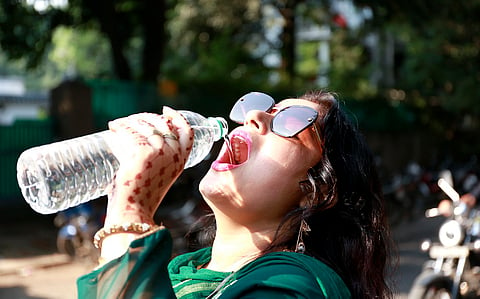

A global report published on the sidelines of the 30th Conference of the Parties to the United Nations Framework Convention on Climate Change in Brazil’s Belem has mentioned the heat stress of Kolkata and Delhi.
The report, prepared by the United Nations Environment Programme (UNEP), found that cooling demand could triple by 2050 under business-as-usual scenarios, driven by increases in population and wealth. Extreme heat events and low-income households are causing cooling to become more polluting and inefficient, according to the analysis.
The findings are extremely relevant in the context of India which suffers from both high pollution and inefficient cooling. The report pointed to the problems of major Indian cities. “Delhi and Kolkata in India face heightened heat-related morbidity and mortality, lower labour productivity, and stressed water systems due to extreme heat and infrastructure challenges,” it observed.
The assessment claimed that cooling-related greenhouse gas emissions are expected to double in 2050 compared to the 2022 benchmark, pushing cooling emissions to an estimated 7.2 billion tons. This, despite efforts to improve energy efficiency, phase down climate-warming refrigerants and overwhelm power grids during peak load.
“Cooling’s climate challenge is a double-edged sword: to expand affordable, sustainable cooling approaches for adaptation, while cutting the energy and carbon footprint of cooling for mitigation,” Inger Andersen, under secretary-general of the United Nations and UNEP executive director, told this correspondent on the sidelines of the launch.
The document, a copy of which is with this correspondent, stated that in 2022, “greenhouse emissions from refrigeration and air-conditioning equipment totalled an estimated 4.1 billion tons of carbon dioxide equivalent globally, of which roughly one-third was from refrigerant leakage and two-thirds from energy use.”
The analysis suggested adopting a ‘Sustainable Cooling Pathway’, which could reduce emissions to 64 per cent — 2.6 billion tons — below the levels expected in 2050.
The document mentions India’s heat issues and programmes around 10 times, underlining the country’s risk from the sector.
The 2024 heatwave saw Delhi-based hospitals report 275 deaths by late June, though the actual number may be significantly higher.
According to the statistics sourced, extreme heat currently results in a 4 per cent loss of Delhi’s total economic output due to reduced worker productivity. The figure is projected to increase to 5 per cent by 2050. Incidentally, despite accounting for only 9 per cent of Delhi’s economic output, construction workers bear one-third of the city’s heat-related economic losses as they mainly work outdoors. A study found that informal workers in Delhi experienced a 40 per cent reduction in earnings during the May-June 2019 heatwave, compared to non-heatwave days.
“Heat stress in Delhi is exacerbated by high levels of air pollution, which worsens health outcomes. For children in poverty, this combination of heat and air pollution is estimated to reduce life expectancy by up to five years compared to wealthier residents,” said an expert.
“During May 2024, Delhi’s electricity demand surged beyond 8,300 megawatts due to extreme heat and heavy air-conditioning use, pushing the grid to its limits and triggering blackouts in some areas,” read the report.
The UN report also pointed out that the rise of average temperature in Kolkata was highest — 2.67 degree Celsius — during 1958-2018 within 20 global cities and regions studied.
A study by Delhi-based environment think tank Centre for Science and Environment showed that no part of the city has been spared from the effects of rising temperatures, with close to half of wards within the Kolkata Municipal Corporation limits falling in the category of either ‘high’ or ‘moderate’ heat vulnerability.
The analysis, a copy of which is with this correspondent, attributes the rising average Celsius in Kolkata to ‘shrinking’ green verges and water bodies.
“Heatwaves are major threats to any city in India with high population and Kolkata is no exception. Kolkata needs a heat action plan at the earliest,” said Subimal Ghosh, a climate scientist at the Indian Institute of Technology, Mumbai, and also a lead Intergovernmental Panel on Climate Change report author.
The UN report also chose to mention a few efforts in India that are trying to counter rising heat stress.
“Government efforts such as India’s National Disaster Management Authority aim to minimize heat-related mortality by prioritizing passive cooling in schools, urban areas, and affordable housing (while) farmers in Bihar, India, are deploying sustainable cold chain systems to reduce post-harvest losses and stabilize incomes,” read the report.
It also mentioned about the Infosys Crescent building located In Bangalore that got completed recently. A radiant cooling system is paired with a dedicated outdoor air system at the building, delivering high indoor air quality and superior cooling capacity.
The UN assessment also mentioned field trials in Palava City at Thane district of Maharashtra, where “super-efficient air conditioners reduced energy use by 60 percent, halved peak demand, and maintained comfort access across both temperature and humidity”.
The analysis also mentioned India’s “urgency of integrating passive cooling strategies” as extreme heat events have led to surges in electricity demand and grid instability; as well as “Million Cool Roofs Challenge in India” that promotes local champions to implement cool roof solutions for vulnerable communities.
According to the report, Jodhpur, in Rajasthan, unveiled its first net-zero cooling station in 2024, showcasing sustainable cooling solutions.